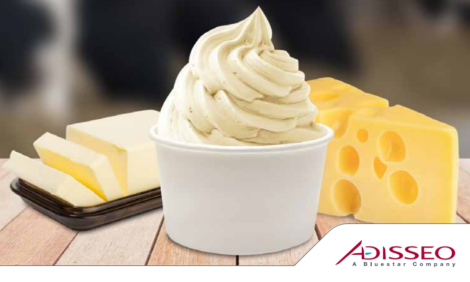



Conjugated Linoleic Acid (CLA) in animal production and human health
Conjugated linoleic acid (CLA) occurs naturally in ruminant milk fat and meat, but diet changes can affect the amountsIntroduction
Dairy products and meat from ruminant animals are important sources of nutrients, supplying high quality protein, energy, and a variety of minerals and vitamins. Research during the last few years reveals other nutritional benefits to the consumption of ruminant food products, particularly dairy products.
There is one compound in particular, conjugated linoleic acid (CLA), that excites scientists, consumers, and producers, and may have far-reaching, positive effects on milk and meat consumption. CLA brings a promising approach to redesigning food because milk has high levels of CLA, and CLA has been shown to have numerous potential benefits for human health, including potent cancer-fighting properties.
ABC'S of CLA chemistry
All milk contains some fat (3.2 to 4.7%), but within milk there are a couple hundred different types of fat and fatty acids. The major fatty acids in milk fat range from 4 to 20 carbon chain length. Linoleic acid, an essential dietary fatty acid, contains 18 carbons (C) with two double bonds (C18:2) (see Figure 1-C). CLA is a term for specific isomers (forms) of linoleic acid with conjugated double bonds (double bonds adjacent to each other C=C-C=C).
Of the 20 different isomers of CLA that have been identified, the cis 9-trans 11 (9c, 11t) (see Figure 1-B) form (commonly called "rumenic acid") is believed to be the most common natural form of CLA. The trans 10-cis 12 isomer (see Figure 1-A) has also been identified. Researchers are also identifying and studying other potentially active isomers.
CLA was first isolated and identified in the 80s by Dr. Michael Pariza at the University of Wisconsin. Dr. Pariza isolated CLA while looking for a compound in cooked hamburger that prevented skin cancer in mice. The cis 9, trans-11 isomer (Figure 1-B) is the form most commonly found in ruminant animals, and is the isomer thought to be most effective in lowering the risk of cancer in humans.
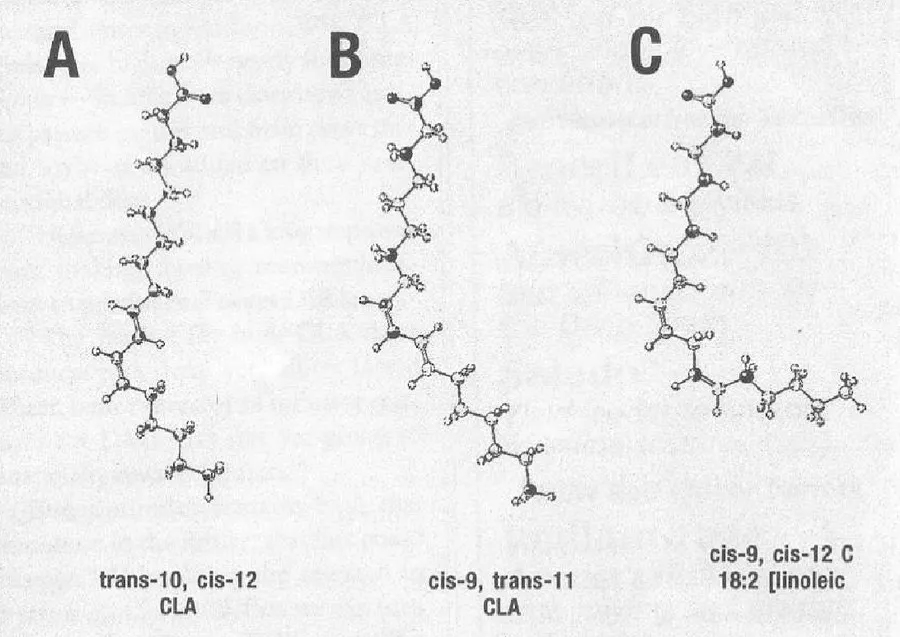
CLA synthesis
Ruminal bacteria are key to the formation of CLA which explains why CLA production is unique to and found almost exclusively in food products (milk and meat) produced from ruminant animals. A detailed schematic of CLA production in the dairy cow is illustrated in Figure 2. In the rumen, CLA is an intermediate of the biohydrogenation of linoleic acid to stearic acid. Biohydrogenation is a collective term used to describe the conversion of unsaturated to saturated fatty acids via isomerization and hydrogenation of unsaturated fatty acids by rumen bacteria. This process is speculated to be a defense mechanism by rumen bacteria against potentially toxic unsaturated fatty acids.
During biohydrogenation of fatty acids, including the CLA intermediate, fatty acids are continually leaving the rumen, being absorbed across the small intestine, and incorporated into milk fat. The biohydrogenation and formation of CLA from linoleic acid has long been known as a source of CLA in the rumen. Another major source of CLA is generated by other intermediates of biohydrogenation and sequential CLA synthesis in the mammary gland. Biohydrogenation of oleic, linoleic, and linolenic acid all result in trans-11 (18:1). The trans-11 can be converted to 9c, 11t CLA in the mammary gland by the tissue delta 9 desaturase enzyme (Figure 2). The importance of both of these sources has been studied, and mammary synthesis may account for up to 70 to 80% of total CLA found in milk. However, it is important to keep in mind that the substrate for mammary CLA synthesis originates in the rumen through microbial biohydrogenation. This demonstrates that the rumen is still a primary source of CLA production.
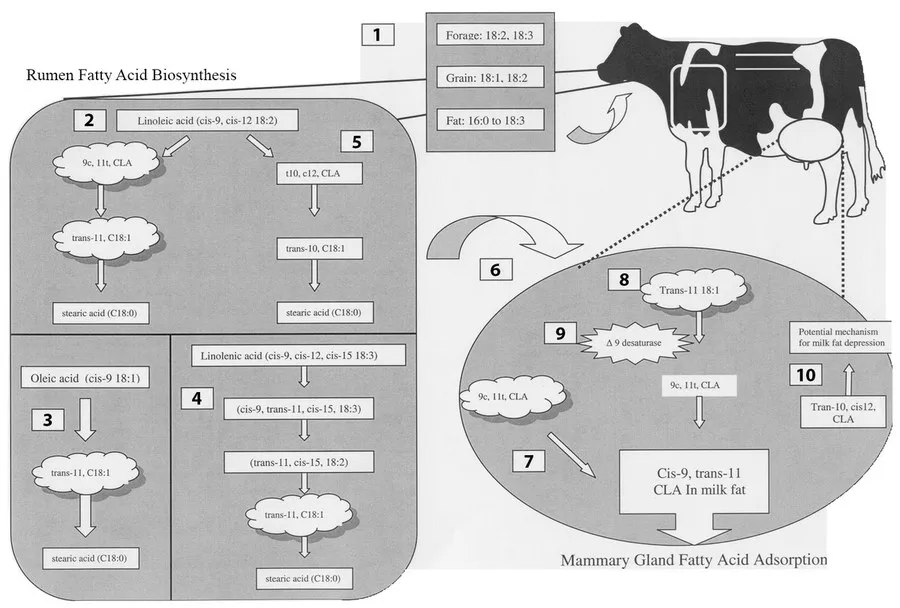
Biosynthesis of CLA effectively has one source - the rumen - and more specifically, the rumen microbes. However, there are two different pathways CLA synthesis. In the diagram above, the cloud caption around a fatty acid designates that fatty acid as one that can escape complete biohydrogenation and be incorporated into milk as CLA or as substrate for tissue synthesis of CLA. The captions below provide explanation for each of the numbered steps in the diagram.
- Feed provides about 3 to 6% fatty acids to the cow. Fatty acids in forages tend to be high in linoleic (18:2) and linolenic acid (18:3). Fatty acids in grains tend to be higher in oleic and linoleic acids. Fat supplements range in form from vegetable oils (16:0, 18:1,18:2, 18:3) to calcium salts of fat (16:0,16:1,18:0, 18:1,18:2, and 18:3) to hydrogenated fats (16:0, and 18:0).
- Linoleic acid: The predominant pathway for biohydrogenation of linoleic acid. Rumen microbes isomerizes linoleic acid to CLA and further hydrogenates it to trans-11, and stearic acid.
- Oleic acid: Recently, has been shown to be isomerased to several different trans fatty acids before hydrogenation to stearic acid. Trans-11 18:1 is a major trans isomer formed and a precursor to CLA formation in the mammary gland.
- Linolenic acid: Biohydrogenation of linolenic acid does not produce CLA in the rumen. However, trans-11 is an intermediate step in biohydrogenation to stearic acid.
- Linoleic: Recently, a minor pathway for the formation of trans-10, cis-12 CLA was proposed. A shift in rumen fermentation may cause an increase in 10t, 12c, (CLA) and passage from the rumen.
- Small intestine: All products and intermediates of biohydrogenation have an opportunity to escape the rumen and be absorbed across the small intestine. These fatty acids may be taken up by the mammary gland (items 7 to 10) and incorporated into milk.
- Preformed CLA: CLA is taken up by the mammary gland from the biohydrogenation of linoleic acid in the rumen. This CLA can be incorporated into milk fat.
- Mammary uptake of Trans-11: A major source of CLA in milk. The trans-11 18:1 is taken up by the mammary gland and is formed by the biohydrogenation of oleic, linoleic, and linolenic acids in the rumen.
- Tissue synthesis of CLA: A mammary enzyme and the key to CLA in milk. The delta 9 desaturase is an enzyme capable of inserting a double bond at the 9 carbon of fatty acids. CLA is formed for the insertion of a double bond at the 9 carbon of trans-11 18:1. This pathway can account for up to 80% of CLA in milk.
- Mammary 10, 12 CLA: The 10t, 12c, CLA isomer has been shown to cause a milk fat depression in dairy cows.
Dietary sources of CLA for humans
Dairy products are the major dietary source of CLA, but CLA is also found in the meat from ruminants. Of the many different isomers of CLA, 85 to 90% are the biologically active (cis 9, trans 11) anti-carcinogen form. Concentrations of CLA are generally expressed as milligrams (mg) of CLA per gram (g) of fat. Most dairy products contain about 3.5 to 6.0 mg/g fat, or 0.35 to 0.65% of the milk fat (Table 1).
Homogenized whole milk contains about 5 mg CLA/g of fat. The CLA concentration in milk is relatively stable over a range of processing, manufacturing, and storage conditions. Thus, the CLA levels found in dairy products are dependent on the CLA concentration in raw milk. The CLA concentrations in meat (beef and lamb) are clearly higher than the CLA in poultry and fish (Table 1).
Table 1. Representative/relative concentrations of CLA in uncooked foods.
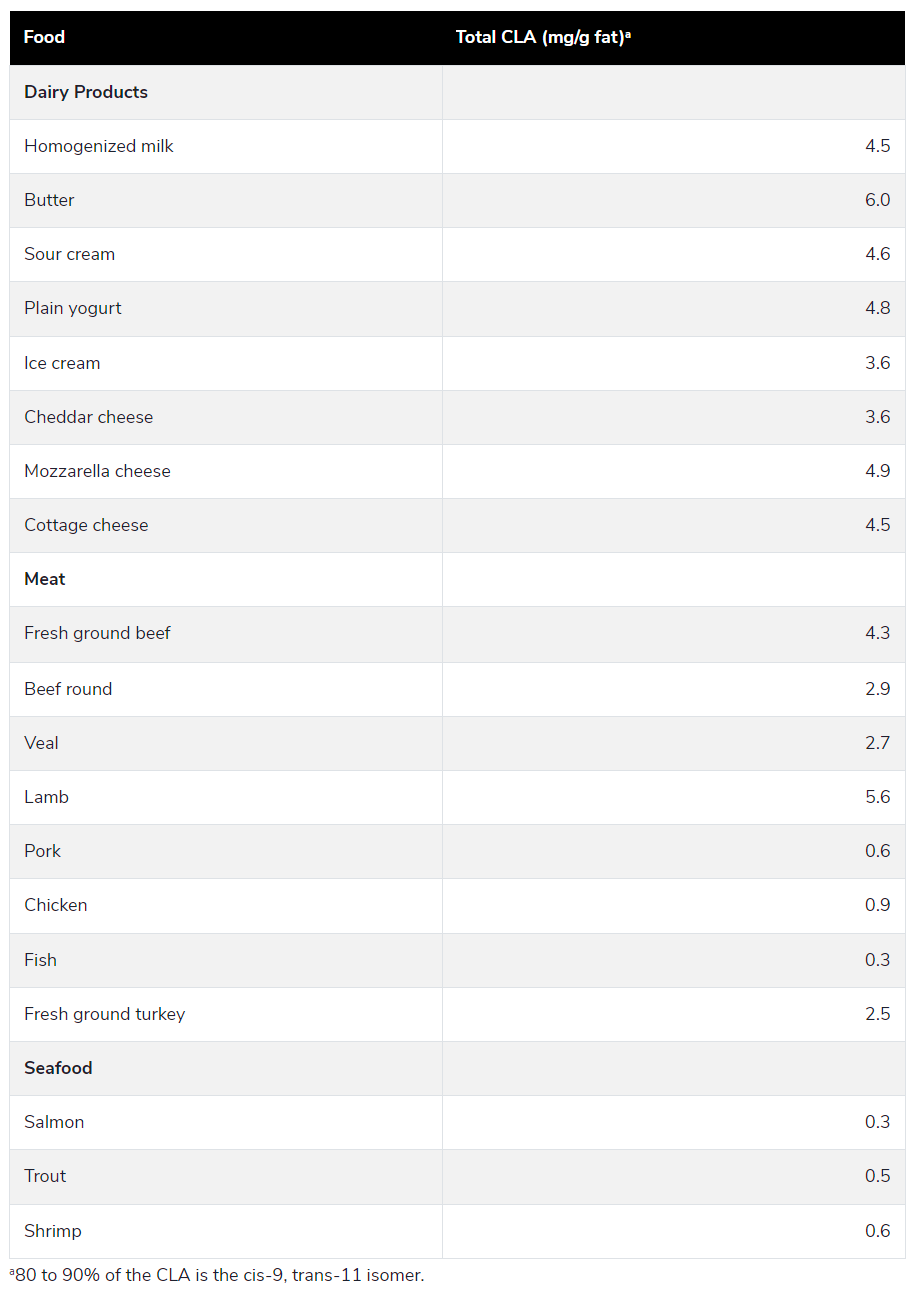
Boosting concentrations of CLA in milk
Surveys have found an eight-to-ten fold variation in CLA concentrations in milk. This suggests that nutrition and herd management practices may create a rumen environment that alters biohydrogenation of fatty acids and, in turn, the CLA concentrations in milk. In Table 2 are listed the nutritional and ruminal factors that affect CLA concentration in milk fat.
Table 2. Factors affecting CLA concentrations in milk fat.
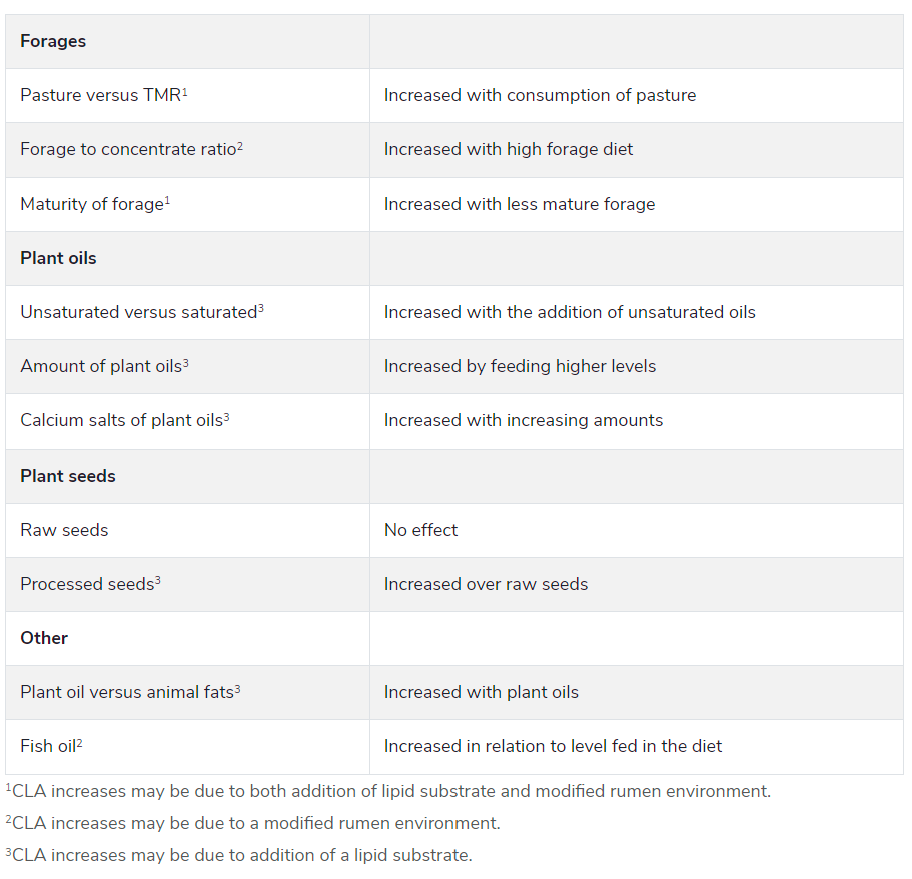
Increases in CLA in milk were first noticed over 65 years ago when cows were turned onto spring pasture. The interest in CLA has renewed the interest in increasing the CLA content of milk. A study at Penn State reported a two-fold increase in CLA with pasture (5.4 to 10.9 mg/g of fat) (Table 3). Wisconsin research reported a four-fold increase (Table 3). This increase has been attributed to increased supply of fat substrate, and to potential changes in the rumen environment and synthesis in the mammary gland. Adding supplements to the ration of grazing cows may diminish this effect.
Table 3. Feeding pasture vs. TMR on the content of CLA in milkfat.

Replacing conserved forages with fresh pasture clearly increases CLA concentrations in milk. A study comparing confinement feeding of a TMR to pasture + TMR (pTMR) and pasture plus concentrate (PC) clearly shows that feeding pasture elevated the CLA in milk (Figure 3). CLA in the milk of cows fed a TMR was constant at 6 mg/g fat for the 18-week study. Cows fed pasture plus concentrate had elevated CLA in milk by week 4 and 6, and the concentration peaked at 18 mg/g fat at week 18. Cows fed pasture plus a TMR had CLA concentrations closer to that of cows fed TMR in confinement.

Fat supplementation and feed sources richer in unsaturated fatty acids have been shown to increase CLA in milk. Unsaturated plant oils increase CLA more than feeding saturated animal fat sources. This is due to the lipid substrate available by the plant oils for biohydrogenation to CLA and CLA precursors in the rumen. It follows then that increasing levels of plant oil and feeding calcium salts of plant oils will increase levels of CLA in milk.
Feeding plant seeds high in fat such as soybean, cottonseed, sunflower, and flax (linseed) has also increases CLA in milk. However, if seeds are fed in a raw form, there is little change on CLA in milk (Table 2). The seed coat must be broken making the fat available to rumen biohydrogenation for CLA production. Supplementing with fish oil has been shown to increase CLA content of milk when dairy cows on pasture were fed high oil seeds, the CLA content of milk increased more than when feeding pasture alone.
If we think back to the biosynthesis of CLA (Figure 3) and the nutritional factors that increases CLA in milk, it is obvious there are many pathways and nutritional factors that can increase CLA content of milk. Employing these nutritional factors together may increase CLA content of milk beyond any one factor.
A study was conducted to increase the levels of CLA in milk by affecting rumen biohydrogenation and supplying lipid substrate. Cows were fed a TMR with the addition of corn oil, fish oil, or both. Including fish oil has been shown to inhibit biohydrogenation allowing more intermediate products of biohydrogenation, including CLA and CLA precursors, to escape the rumen and be incorporated into milk. Lipid substrates such as corn oil has shown to increase CLA content of milk by providing more unsaturated fatty acids for biohydrogenation. When cows were fed both corn oil and fish oil in combination, CLA content in milk increased ten-fold (Table 4).
Table 4. Combination factors affecting CLA concentrations in milk fat.
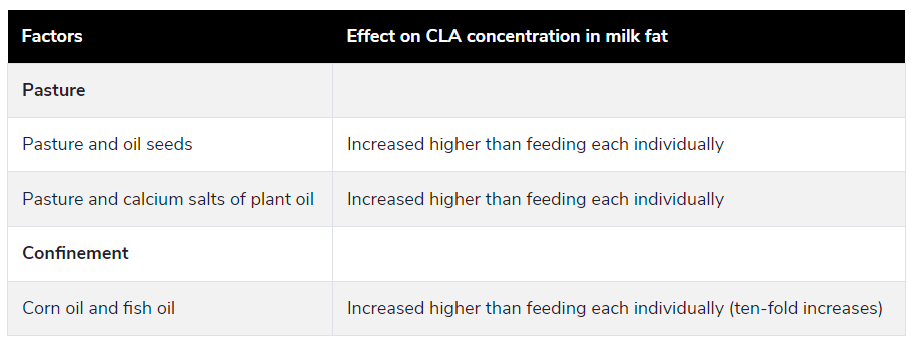
Meat products
The CLA content of meat from ruminant animals is generally less than the CLA in dairy products (Table 1). Grass fed beef tends to have small increases in CLA compared to grain fed. However, if grass fed beef are finished on higher grain diets prior to slaughter, the CLA content in meat decreases. In general, diet has a small effect on CLA in beef compared to the dietary influence on dairy products.
Potential health benefits
The potential benefit of CLA in human health is the major reason for the excitement and interest in CLA. The major interest surrounding CLA is the anti-carcinogenic or anti-cancer effects. The National Academy of Science publication entitled "Carcinogens and Anti-carcinogens in the Human Diet stated that "conjugated linoleic acid is the only fatty acid shown unequivocally to inhibit carcinogenesis in experimental animals." Much of the research to date has been with laboratory animal models. CLA can reduce new tumor growth and destroy existing tumor cells. CLA has killed existing cancer cells in colon, ovarian and prostate carcinoma, leukemia, melanoma, and breast tumors. CLA-enriched butter inhibited rat mammary tumor yield by 53%, clearly showing the cis-9, trans-11 isomer was anti-carcinogenic. In addition to the anti-carcinogenic properties, other positive health benefits demonstrated in animal models include:
- Reduced atherosclerosis
- Enhanced immune system
- Prevention and treatment of diabetes
- Weight reduction; reduced body fat and increase body protein
- Enhanced bone formation
Although much research has been conducted with laboratory animals, specific studies comparing risk of cancer and CLA consumption by humans have been limited to date. Caution is needed when applying these results to humans. However, an epidemiological study in Finland revealed that as women consumed more dairy products, the risk of breast cancer dropped. Researchers concluded there was a "protective effect" associated with milk. A study in France showed an inverse relationship between CLA concentrations in milk and the risk of severity of breast cancer. As research continues on many fronts, the specific physiological effects and the responses will be better defined.
CLA enriched milk - a new product opportunity?
This document illustrates the feasibility of producing CLA enriched milk and meat. An important question is whether the increase achieved will translate into a real benefit for the person consuming the milk. Extrapolation from animal studies suggests that humans may need to consume about 3 g of CLA per day. Using the CLA percentages in Table 1, one serving of whole milk plus a sandwich with butter and cheddar cheese will provide about 1.5 g of CLA. To achieve 3 g intake of CLA per day intake, modifying the diet of dairy cows to increase CLA in milk and increased consumption of higher fat dairy products would be needed.
The concept of enhancing the levels of health promoting fatty acids in food is not new. One example of this has been the introduction of eggs enriched in omega-3 fatty acids. This recognizes the trend among consumers is toward an increased desire to make diet choices that promote good health. Consumers could increase their CLA intake by taking synthetic CLA in pill form, which is available in health food stores. However, the main difference between the CLA in these products and CLA in milk is the broader range of isomers in the synthetically produced CLA. The relative value for human health of this range of CLA isomers compared to the CLA found in ruminant milk fat is uncertain. However, most of these isomers are not thought to have anti-carcinogenic properties.
Nevertheless, CLA-enriched milk produced through manipulation of the ration fed to cows has an advantage over this type of product in that it can be promoted as a "natural" source of CLA. It may also be easier for CLA-enriched milk to gain acceptance since milk already has a wide distribution and consumers are accustomed to seeing a broad variety of dairy products in the grocery stores. A challenge will be in overcoming the existing public perception regarding milk fat and health.
CLA-enriched milk may be attractive to those consumers who have abandoned milk and milk products, such as butter, due to concerns over the impact of milk fat on their health. However, the introduction of new products like CLA-enriched milk does require significant investment in marketing and there are no guarantees that the product will attract sufficient consumer interest to be viable. The incentive for producers to feed special diets needed to enhance CLA levels may require a higher price for the milk.
Conclusion
The presence of a compound (CLA) in ruminant fat with such potent health promoting effects has been an unanticipated discovery. The ability to enhance the concentration of CLA through manipulation of the dairy ration demonstrates the feasibility of producing CLA enriched dairy products. As consumers become more conscious of the link between diet and health, milk designed to have enhanced levels of CLA may provide new market opportunities for milk and milk products such as butter and cheese.


